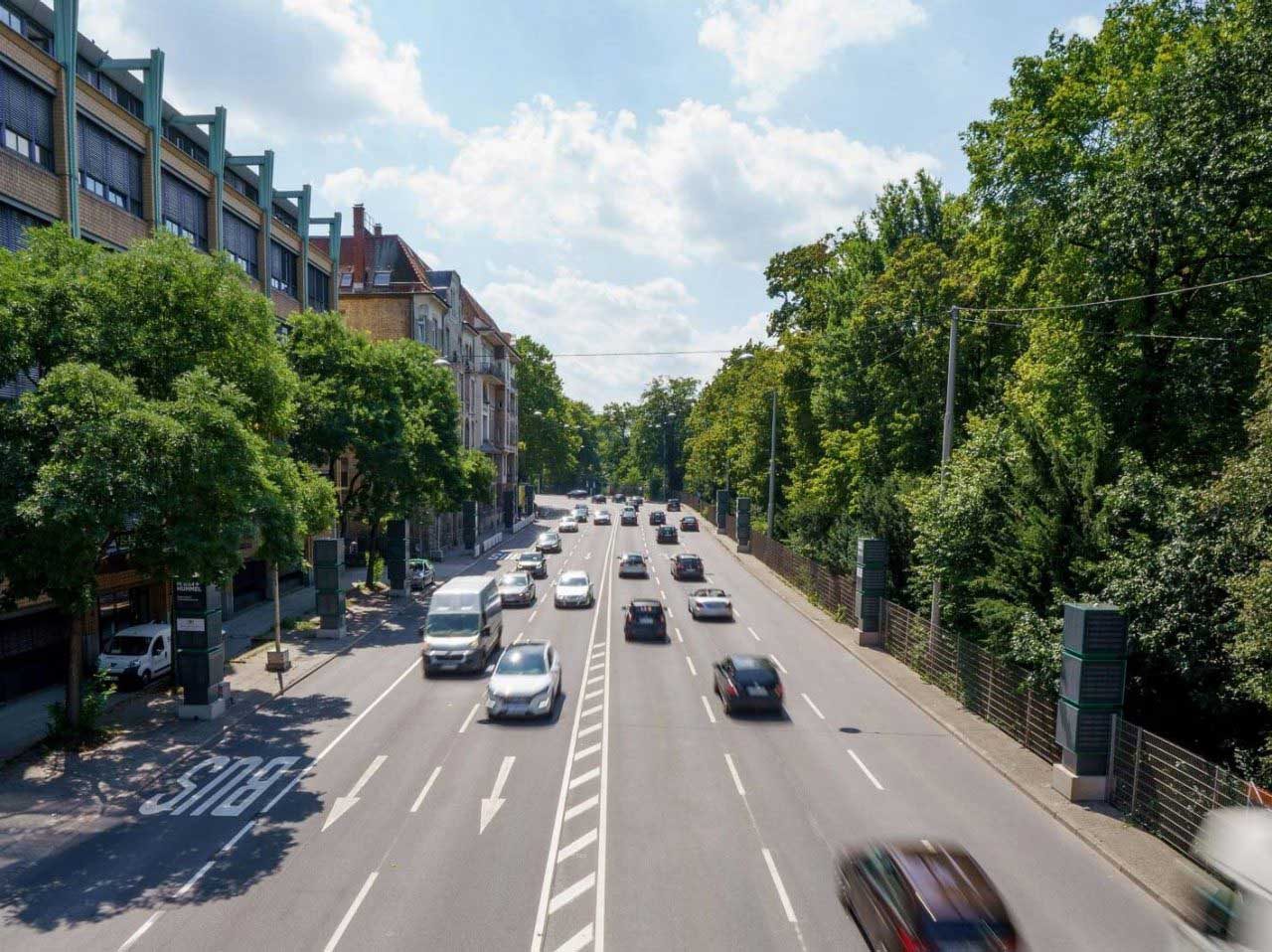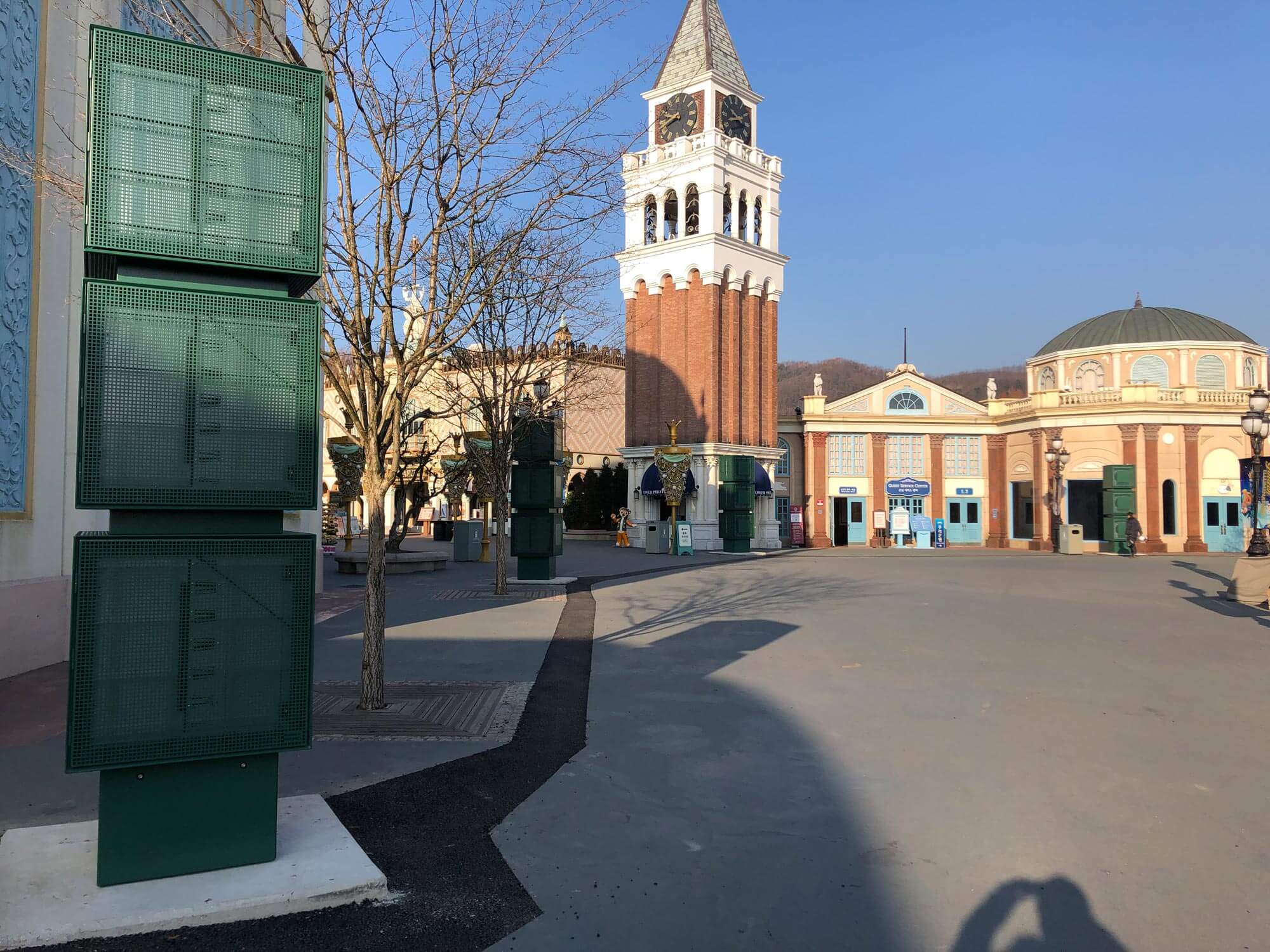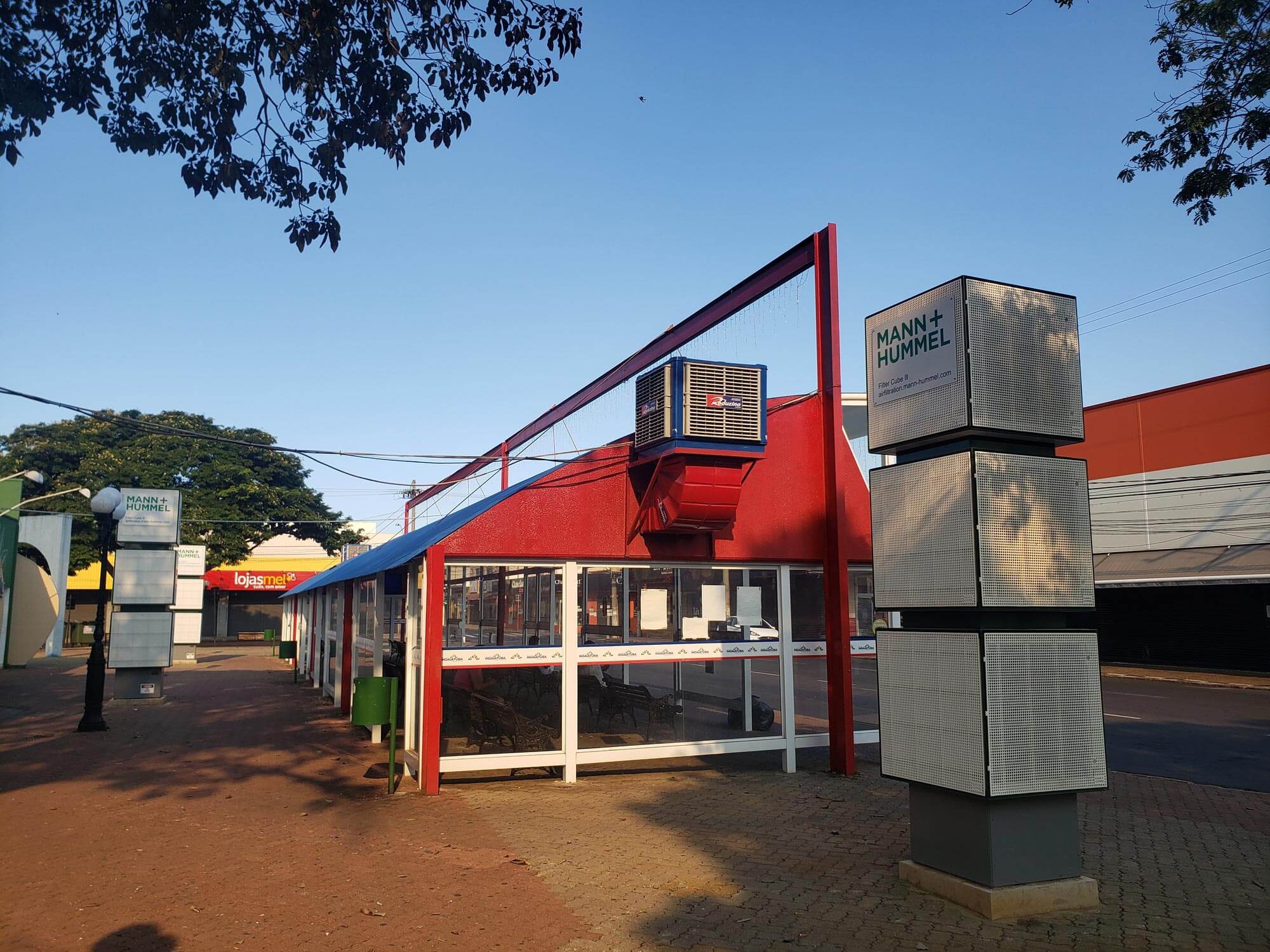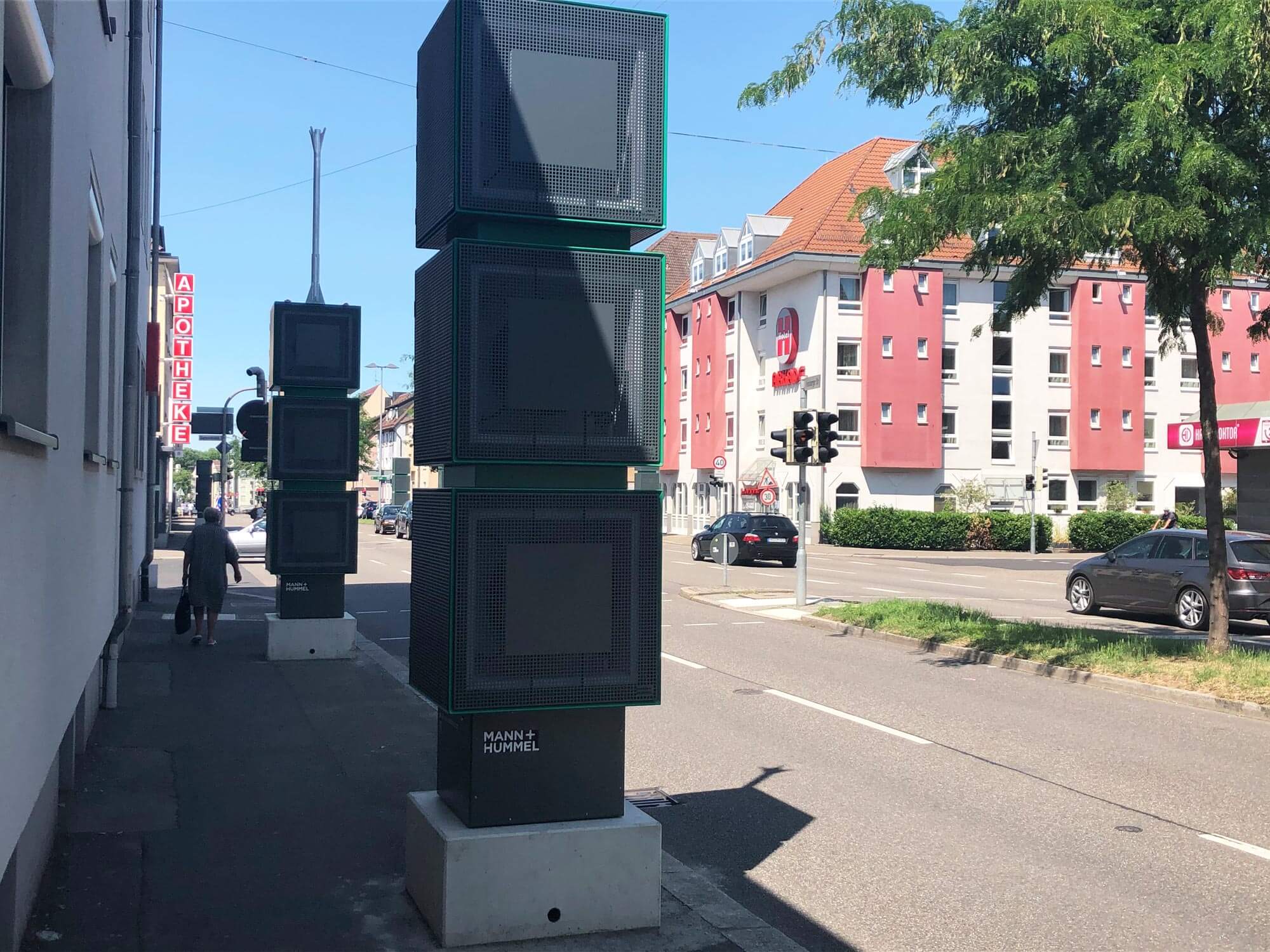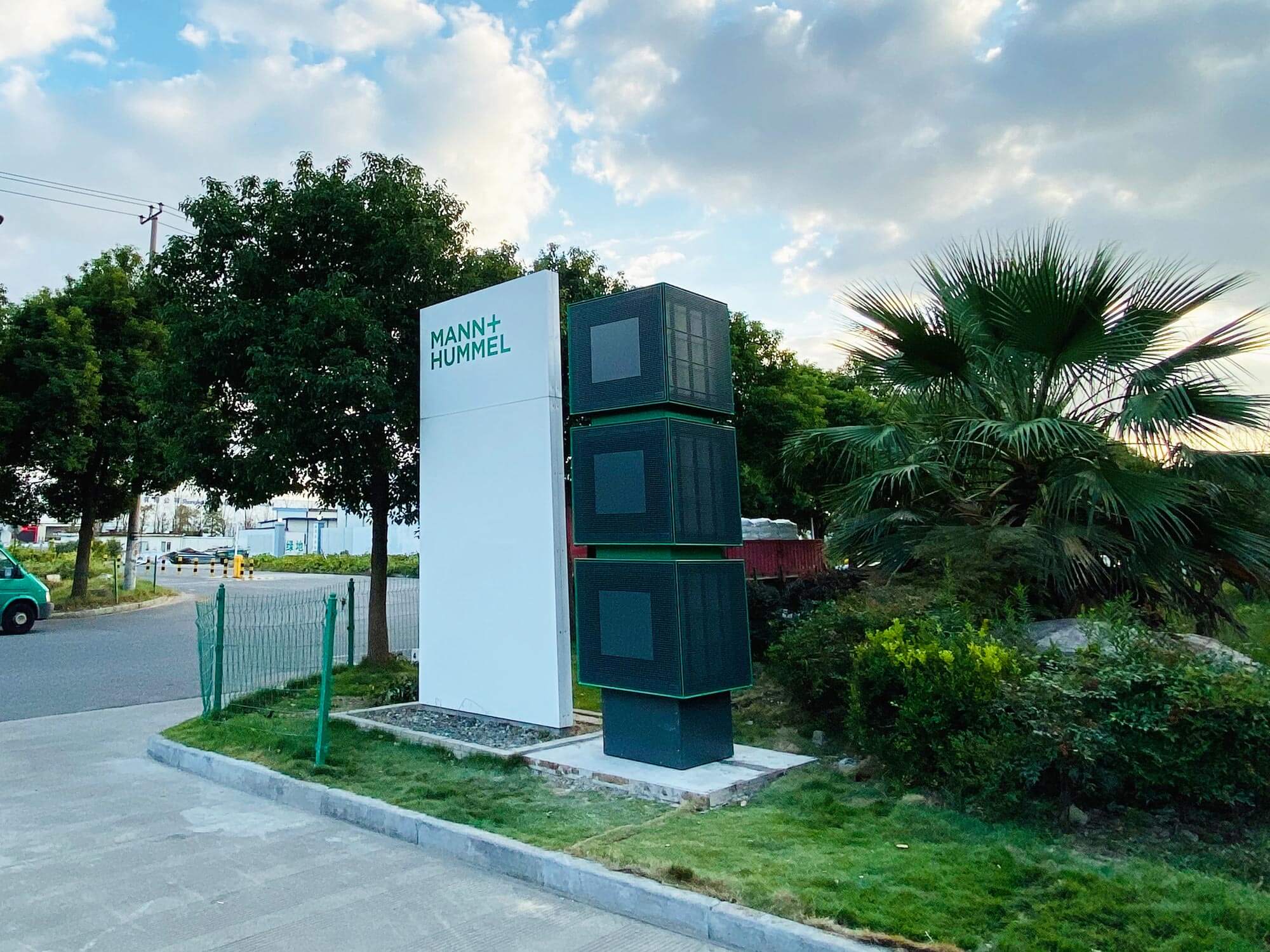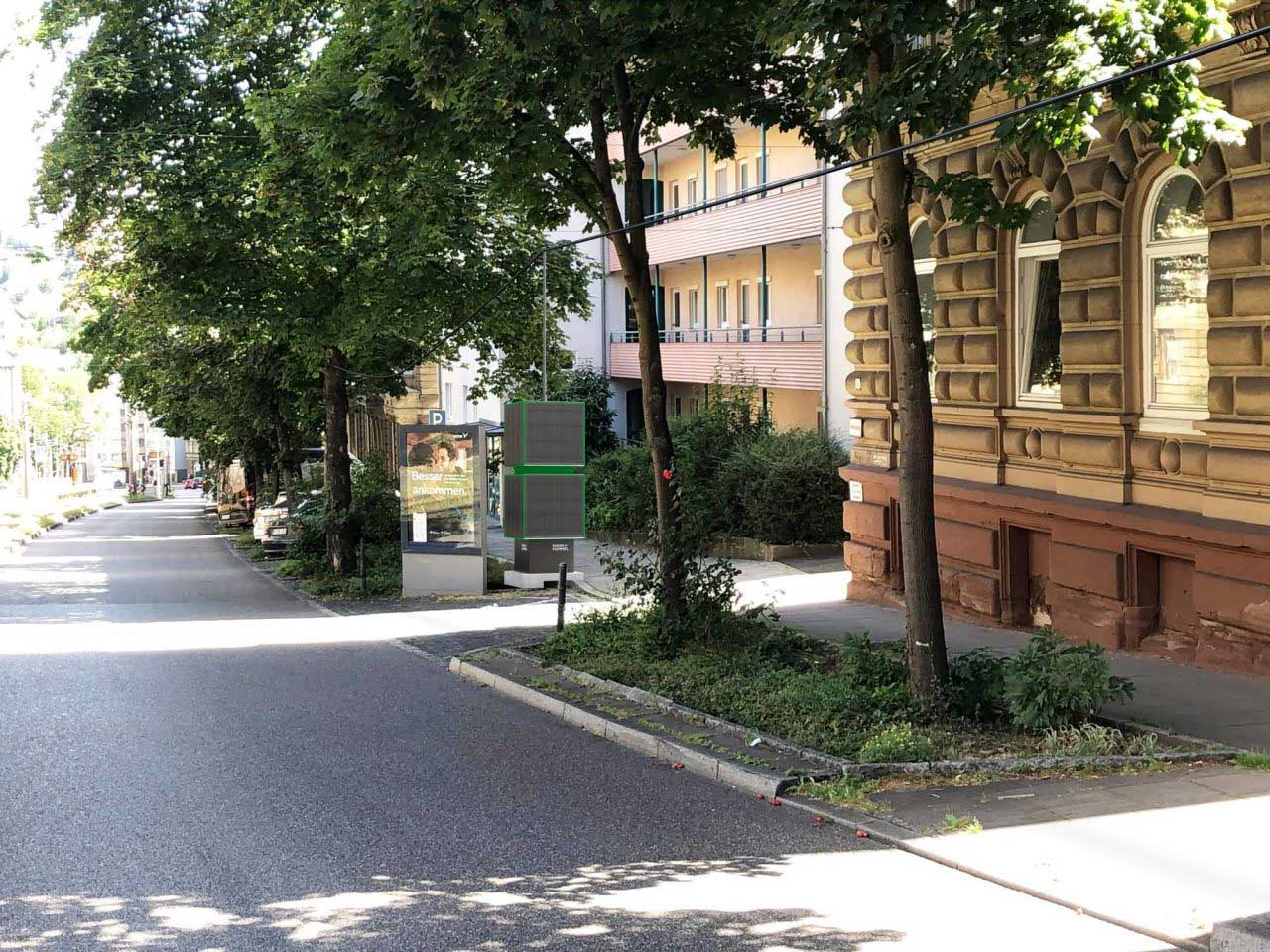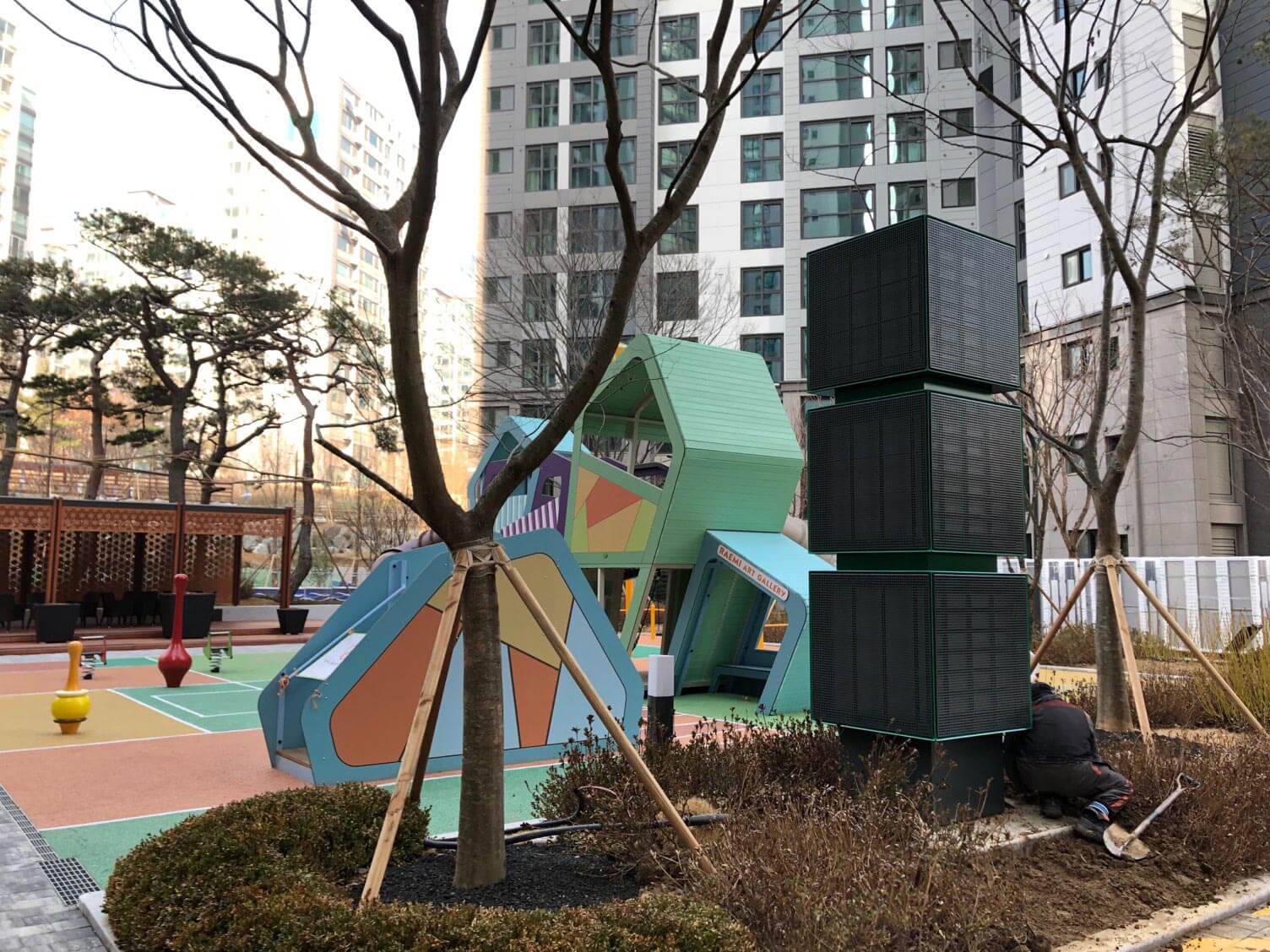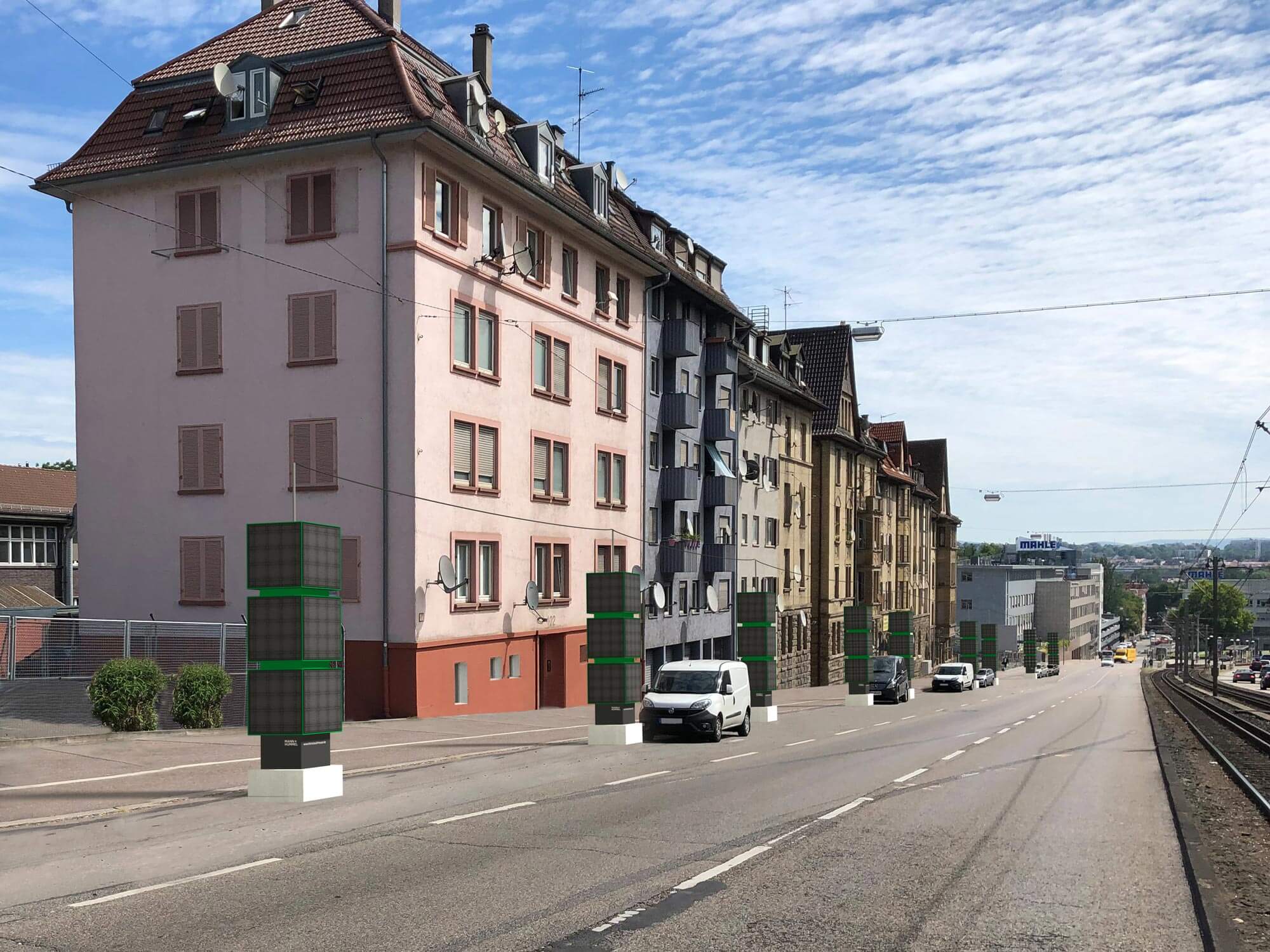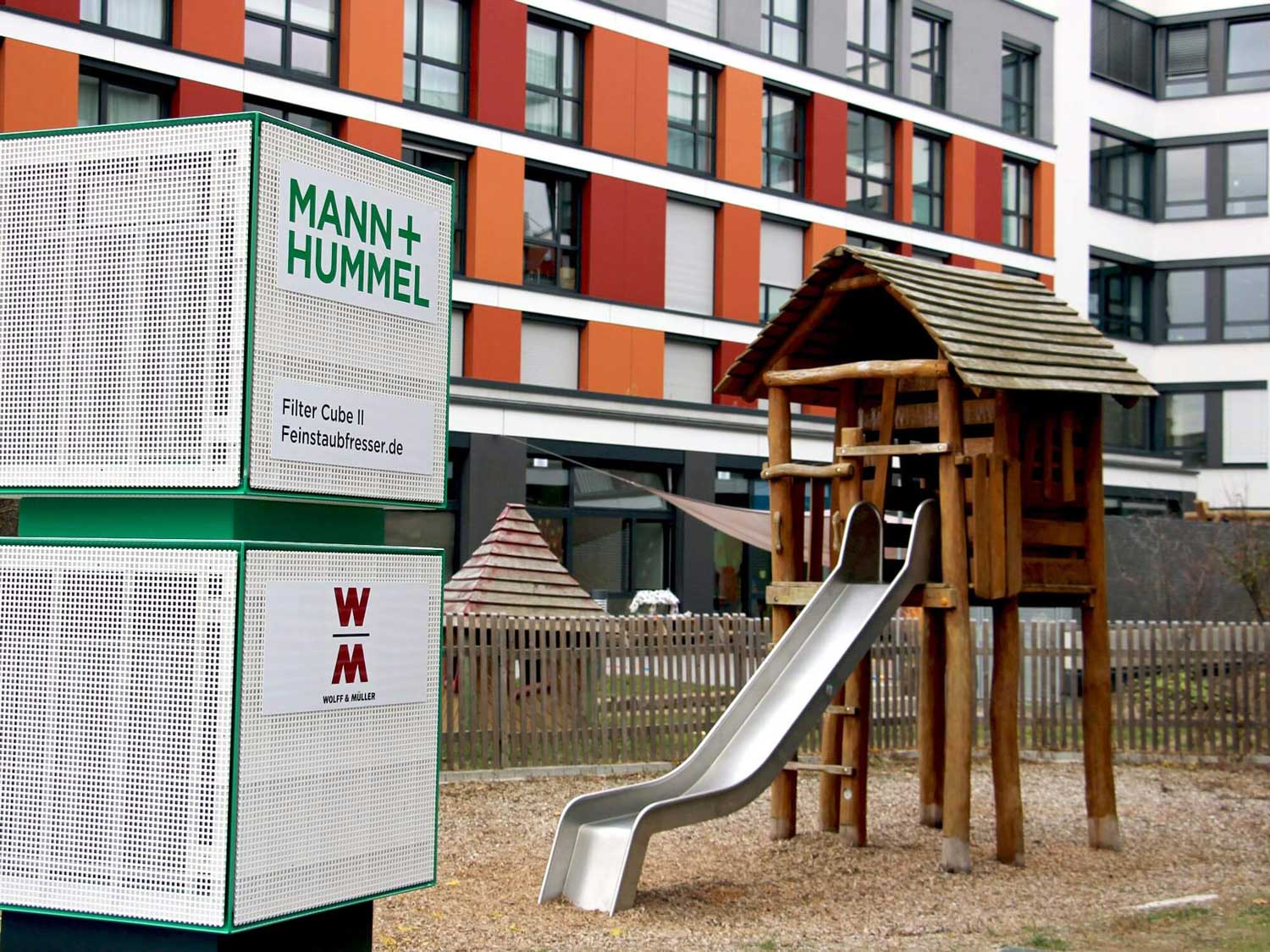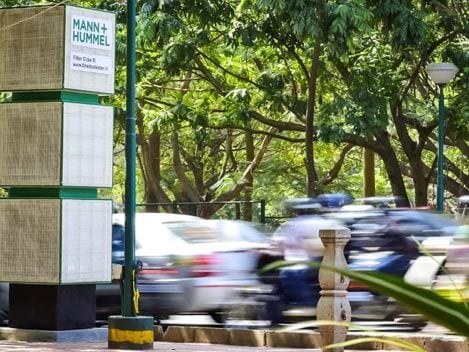Filter Cubes and Filter Squares: Powerful outdoor air purifiers for pollutant hotspots
The challenge – polluted air in cities
Sources such as traffic and industry cause high concentrations of particulate matter and nitrogen dioxide (NO2). All across Europe, the exceedances of limit values are a constant source of discussion. In high traffic areas or places with large emissions and low air exchange, the exposure is especially high and the effect on human health is harmful.
This applies, for example, to busy streets and traffic hubs. The danger is even greater in underground rail stations, where rail abrasion generates metal-bearing particulate matter. People with respiratory illnesses, the elderly or children should not be exposed to high concentrations of particulate matter or nitrogen dioxide. Surrounding yourself with clean air is a quality of life necessity. In places where people are studying, working, shopping or spending their free time, it is important to be surrounded by clean air.
Under the European Green Deal’s zero pollution action plan, the European Commission set the goal to reduce the number of premature deaths caused by PM2.5 by at least 55% by 2030, compared to 2005.
More about the EU GREEN DEAL
We have the solution for better air quality in urban centers:
Filter Squares provide better air in subway stations and large indoor spaces

The danger lurks underground: In underground train stations, the air pollution level is often particularly high, up to 10 times higher than in the air in the free atmosphere above. Brake dust and rail abrasion release metal-bearing fine dust into the air. These often tiny particles can penetrate deep into our bodies and cause serious illnesses. Trains arriving and departing the station constantly stir up the deposited fine dust. In addition, the air exchange is usually very poor.
The MANN+HUMMEL Filter Square is a free-standing air purifier that combats fine dust and other airborne pollutants in spacious, semi-open areas where space is at a premium. Thanks to its innovative system design, the Filter Square is capable of cleaning 3,600 m³ of air per hour. When two Squares are stacked on top of each other, even 7,200 m³/h of airflow can be achieved in just half a square meter of floor space.

This makes it ideal for use in subway stations, where the Filter Square can provide the required performance without taking up much space on the platform or passageways. And because Filter Square is a fully modular system, it can be easily adapted to large spaces with varying ceiling heights. But its modern, unobtrusive and variable design also makes Filter Square ideal for shopping malls, airport check-in halls and underground parking garages.
The Filter Square binds more than 80 % of fine dust particles and other air pollutants from the intake air. The innovative filter media inside the air purifier are characterized by particularly low resistance. This means that the Filter Square can drastically reduce the fine dust pollution caused by brake dust and track abrasion with minimal energy consumption.
In the development of the modular air purifiers, emphasis was also placed on low noise emission. In enclosed spaces, such as subway station platforms, as well as shopping malls and hotel lobbies, noise bounces off the walls and ceilings. The Filter Square features a low-noise fan and a sound-optimized design to minimize the noise generated by the unit.
Filter Cubes - Large and powerful for outdoor
The modular MANN+HUMMEL Filter Cube helps to improve air quality in places with high levels of air pollution, such as traffic junctions or busy roads. The use of Filter Cubes is also useful in particularly sensitive areas, such as schoolyards, playgrounds or outdoor food courts, in order to efficiently reduce air pollutants. Filter Cube technology can also be integrated into existing infrastructure such as bus stops or advertising boards (see Filter Grid).
The decentralized Filter Cubes bind more than 80% of the nitrogen dioxide (NO2), ozone (O3) and fine dust from the ambient air drawn in. At the heart of the technology is a newly developed combination filter that has a filter layer that adsorbs fine dust. Due to the large surface area of the additional highly porous activated carbon media, NO2 and O3 are absorbed very effectively with particularly low pressure loss and energy consumption.
Depending on the requirements, the modular design allows several Filter Cubes to be installed on top of each other to form a filter column. A filter column with three Filter Cubes is capable of cleaning 17,625 m³ of air every hour. The Filter Cubes are equipped with an intelligent mechatronic system architecture. Available sensors record air and weather data as well as pollutant levels and transmit the data to a cloud. In this way, the filter system controls itself depending on operating and ambient conditions and saves energy costs because the fan only runs when needed.
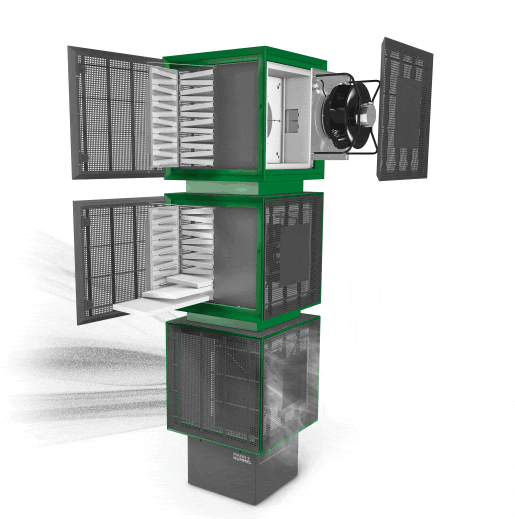
Scientifically proven effectiveness of Filter Cubes
For a long time, the busy heavily frequented street "Am Neckartor" in Stuttgart was one of the places in Germany most polluted by particulate matter and harmful gases. After the effectiveness of MANN+HUMMEL Filter Cubes had previously been confirmed in a joint study with the KIT (Karlsruhe Institute of Technology), the effectiveness of a large-scale installation of filter columns has now been proven in a long-term trial. More detailed information on the procedure and test setup can be found in the final report of the pilot project, which was prepared in coordination with the Baden-Württemberg Ministry of Transport.
Compared to other measures frequently investigated in clean air plans of cities, the installation of a Filter Cube network is more successful than average. Actions such as converting the vehicle fleet to e-vehicles, expanding and promoting bicycle traffic and public transport, software updates and traffic management are usually estimated in the very low, single-digit percentage range in terms of pollutant reduction.
Only driving bans would come close to the effectiveness of the Filter Cubes, but they not only severely restrict delivery and commuter traffic, but also keep consumers away from city centers. Because Filter Cubes clean the air without affecting traffic flow, they are business-friendly while protecting residents and passersby.
The slightly smaller Filter Squares are a further development of the Filter Cubes. They feature the same filtration technology and, thanks to state-of-the-art filter media, they also capture more than 80% of fine dust particles and other air pollutants from the air drawn in. They are used wherever fine dust pollution is high but space is limited or where the highest design requirements have to be met.
Exemplary process of Filter Cube installation
The first step in a project is to take a closer look at the surroundings of the area that has particularly high pollution levels. Whether it's an open area on a busy street, a courtyard in a business district, or a relatively enclosed subway station, our experts make calculations for each of these conditions and consider different measures. They check where particulate matter and NO2 levels are highest and how the pollutants are distributed in the air. They then plan how many Filter Cubes or Filter Squares are needed in the area and where they should be installed. These plans are determined internally by simulation and verified by an independent engineering firm.
A Filter Cube requires 1 m² of space, while 0.5 m² of floor space is sufficient for a Filter Square. Both air cleaners require power access and, if necessary, a data link. Depending on the location and customer requirements, a foundation is also required for the Filter Cube. Once the infrastructure has been prepared on site, the systems can be installed. Thanks to an intelligent system architecture, Filter Cube and Square control themselves depending on the operating and ambient boundary conditions. However, the operator can also control the units remotely and access the system as needed.
Downloads
Filter Square
Reference projects
FAQs
General Information
Critical values for particulate matter and nitrogen dioxide are being exceeded in many cities, affecting the health of city dwellers. MANN+HUMMEL has developed Filter Cubes to reduce the concentration of pollutants in places with particularly polluted air. These are capable of extracting 80 percent of fine dust and nitrogen dioxide from the attracted ambient air with very low energy requirements.
As part of a pilot project, the first Filter Cube columns were installed at Stuttgart's Neckartor in November 2018 to protect residents and avoid driving bans. Following positive results in reducing fine dust pollution, MANN+HUMMEL retrofitted the existing constructions with newly developed combifilters in July 2019. These enable the capture of not only fine dust particles but also nitrogen dioxide from the air.
Thanks to the successful pilot project at the Neckartor, MANN+HUMMEL is the first company that has scientifically proven the effect of the Filter Cubes. This verification was produced in cooperation with the Karlsruhe Institute of Technology and the State Environmental Agency of Baden Württemberg.
We have now installed and commissioned over 25 projects on three continents with a purification capacity of 2,262,350 m³/hour outdoors and in subway stations. By way of comparison, this volume of air is required to meet the air demand of 4.52 million people per hour.
Equipped with energy-efficient fans, the Filter Cubes attract ambient air. This air is filtered with the aid of fine dust particle filters, removing dangerous fine dust particles from the attracted ambient air. If the values of nitrogen dioxide or ozone are also too high, so-called combination filters are used. These have a highly effective filter layer for fine dust combined with a special activated carbon layer. Due to its large inner surface, the highly porous activated carbon is able to absorb NO2 very efficiently. This specially developed combination filter medium enables a particularly high air throughput with very low energy consumption at the same time. This purifies the air with very low energy consumption.
The operation of the filter columns can be adjusted as required via a control unit and thus react to the current air quality. External sensors record air and weather data, which are then merged and analyzed in a cloud.
The effective radius of a column is 15-20 meters. In order to achieve an area-wide effect within a certain road section, we need a network of several columns in which the effective radii overlap. Thus a filtration field can reduce the air pollutants fine dust and NO2 in the person-relevant area (e.g. footpaths) by up to 10-30%.

According to the WHO, around 4.2 million people die each year worldwide from outdoor air pollution. The main cause is fine dust (particulate matter), which can penetrate deep into the lungs and cause disease (see graph on the left: Which particle sizes are dangerous for our body).
Nitrogen dioxide worsens allergies, damages the respiratory tract and can contribute to heart disease.
Fine dust pollution is particularly relevant at particular locations within cities. Very often, these higher emissions can be found at points where more people tend to be. This is true for large road junctions, subway stations, bus stops, or underpasses. The risks to health at these locations are especially high.
For certain groups, the risks from pollutants are above average. People with respiratory diseases, elderly people, or children should not be exposed to increased concentrations of fine dust or nitrogen dioxide.
Clean air is a basic requirement for quality of life. Wherever people study, work, shop, or spend their leisure time, they want to be surrounded by clean air. No one wants to be concerned about fine dust values.
In October 2022, a Filter Squares plant was commissioned at the Saxe-Gambetta metro station in Lyon, France. The installation comprises 8 Filter Squares II, i.e. a total of 16 Filter Squares. The metro station has a length of 45 m, the room height is 6 m, and there are two tracks on which trains enter and leave in one direction each. The air cleaners are distributed above the platforms on two sides of the station.
MANN+HUMMEL air cleaners are specially designed for use in subway stations. Their integrated filters remove up to 80 % of the fine dust/particles from the air drawn in, which directly leads to better air quality.
Construction, costs, electricity
If only the reduction of fine dust from the ambient air is required, particle filters made of highly developed microfiber media are used. At traffic junctions with a high nitrogen dioxide load, so-called combi-filters are used, which have a special activated carbon layer in addition to a highly effective filter layer for fine dust. This layer separates the NO2 from the ambient air by physical adsorption, chemical binding and catalytic reduction.
Each Filter Cube installation is unique, so we cannot mention standard prices. The design (Filter Cube I, II, III) and number of Filter Cubes depend on numerous factors, such as location, pollution, wind conditions, etc. For specific inquiries, please get in touch with the contact persons at the bottom of the page. They will provide you with information specific to your project description.
The energy consumption of our Filter Cubes III is approx. 1.500 W/h. This is comparable to a commercial vacuum cleaner, but with 100 times the air throughput.
The filter columns require a power connection and cannot be operated self-sufficiently, for example with solar energy. To operate the filter columns as sustainably as possible, we recommend using green electricity.
The air volume flow of a Cube III column is 17.625 m3/h. This corresponds to a room the size of a football field with a height of two meters.
A Filter Cube III weighs about 1.000 kilograms.
The filter columns are 3.60 meters high, have a footprint of less than 1 m2 and each consist of up to three stacked components, the cubes. The individual cubes have a side length of almost one meter.
The filters are disposed of as household waste in accordance with existing regulations. It is not hazardous waste because the fine dust bound in the filter is no longer harmful to health.
We want to achieve a reduction in particulate matter and nitrogen dioxide pollution at particularly polluted locations. Using modern separation and catalyst technologies, waste incineration plants in Germany capture hazardous pollutants such as nitrogen dioxide and particulate matter on a large industrial scale in accordance with environmental regulations. What remains at the end is ash that can be deposited in landfills.
Effect and Evidence
The effective radius of a column is 15-20 meters. In order to achieve an area-wide effect within a certain road section, we need a network of several columns with overlapping effective radii. Thus a filtration field can reduce the air pollutants of fine dust and NO2 in the person-relevant area (e.g. footpaths) by up to 10-30%.
Thanks to the pilot project at the Neckartor in Stuttgart, MANN+HUMMEL is the first company that has been able to prove this effect scientifically in cooperation with KIT and LUBW.
Residents and Politics
Depending on the installation area, different requirements apply with regard to noise protection. These are defined in a national Technical Instructions for Noise Protection (TA-Lärm). Our filter cubes comply with the TA noise.
Depending on their location and proximity to residential buildings, individual filters are regulated up or down according to the legal requirements.
We also use technology for sound insulation. We benefit from our acoustics laboratory and our expertise in sound design, which we have gained in the automotive industry.
The measuring stations are installed where the exposure to air pollutants is particularly high. The risk to the health of residents, pedestrians and road users is correspondingly high at these locations. The Filter Cubes from MANN+HUMMEL improve air quality along the road sections where they are positioned. There is no specific and punctual influence on the measuring points.
The MANN+HUMMEL filter columns are part of an overall solution for improving the air quality of the respective cities. Together with other measures anchored in their air pollution control plans, our columns can offer effective protection against particulate matter and nitrogen oxide at particularly polluted locations.
Our whole portfolio for better air quality in cities
Do you have questions? Contact us!


